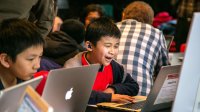Taking Advantage of the Power of Play
Game jams—game creation sessions—can be used in any class to spark learning. Bonus: There’s a free lesson plan to help you get started.
Your content has been saved!
Go to My Saved Content.Can designing games about real-world issues teach students empathy, systems thinking, and design thinking? After organizing a series of game jams last year around serious social issues—immigration, climate change, future cities—I discovered the answer to be an overwhelming yes.
What Are Game Jams?
In a game jam, people gather to design a game based on a theme or topic. Participants have a set amount of time (an hour, an afternoon, a weekend) to work on a project using an iterative design process. Youths work in teams to solve a problem collaboratively.
Game design engages young people to be creative and innovative problem solvers. Many areas of expertise and interests are engaged; thus, students can identify their own strengths and bring them to a team. To create a digital game as a functioning and interactive system, groups need artists, coders, systems designers, and storytellers. Here, all modes of STEAM (science, technology, engineering, art, and math) coalesce. And designing games also happens to be fun.
Game Jams as PBL
Game jams often take place in informal learning settings like museums and libraries, or on college campuses. Hosting an event requires an open space or room with lots of electrical outlets and Wi-Fi. Plenty of pizza helps. But game jams can be part of a project-based classroom, too.
In a classroom, first use a video game or a tabletop game the same way you would use a book or film: Have students spend one or more class periods getting to know it. In the case of a game, that’s done by playing it. In my teaching, I had students play the history-themed Mission US series from PBS. Then I challenged them to design their own sequels using free digital authoring tools like Scratch. In this sense, the game substituted for traditional media, like a text or film. An analogous assignment would be to have students read a story and then write a sequel.
There are many tools to enable game creation on a variety of content themes. Bloxels is a set of colored cubes that fit in a square board. After placing the cubes on the board, open the free tablet app and take a picture. The app then turns the image into a fully playable game level. Students can design a tour of a cell or a location in a book in minutes. For more, check out the tool’s education portal. Other easy-to-use game design tools include Gamestar Mechanic, which also can be used to tell stories. In fact, several of the winners of the National STEM Video Game Challenge built games with it.
Game jams can work at most grade levels, and in just about any content area—the games students make are a tool to demonstrate their learning. Although younger students may require more teacher facilitation, think about how many kindergartners are already adept at designing Minecraft worlds for others to play.
Moveable Game Jams
Last year I was part of a team that organized Moveable Game Jams, which took place on Saturdays at four different locations. Each event began with a warm-up activity—often the whole group played a game. The goal was to get kids to be in a lusory—playful—attitude because play brings learners to the zone of proximal development, where novices become masters. In a classroom, have students play the reverse charades party game HedBanz for a few minutes. Then distribute blank index cards and challenge students to redesign the game based on the content you are covering. This will get kids already in the mindset to play with new, and possibly complex, topics.
The second half of the Moveable Game Jams featured experts related to each content theme: employees of Current by GE for the future communities jam, NOAA and NASA staff for the climate change jam, and two New York City historical museum educators for the local stories and immigrant voices event. You can bring experts into your classroom by hosting a Mystery Skype—students guess who the guest is—or by simply inviting in a guest speaker.
The final part of the Moveable Game Jams was content creation. Participants chose one of four game design stations to visit and were mentored by an adult trainer. I adapted this portion to my classroom by setting up learning zones. One was a board game design station, while the other involved coding.
Free Game Jam Guide
The goal of the Moveable Game Jams was to create and publish a document that would enable any teacher in any subject area to replicate a weekend jam within the constraints of a bell schedule in their classrooms. We collected and edited all of the activities and rewrote them in a lesson plan format. Each game design lesson can fit most course topics. Or you can simply follow one that’s already themed, like the science (climate change) or social studies (immigration, future communities) examples.
We produced a free Game Jam Guide that features over 20 lessons and activities—created with digital learning organizations in the Hive NYC network—that can be used to help students learn about real-world issues.
